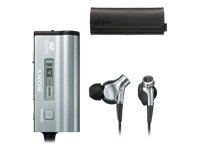
A detailed list of technical data, specifications, ratings and expert review of Sony MDR NC300D. Get a comprehensive look at your chosen headphones and see if these are the ones that will best suit your needs. You can also use the comparison feature to compare with other competing headphones.
design and dimensions sound quality cable battery and charging connections others
| DESIGN AND DIMENSIONS Sony MDR NC300D |
|---|
| Product Type | Earphones - wired - 3.5 mm jack | |
|---|---|---|
| Recommended Use | Portable electronics |
The Sony MDR NC300D are wired headphones. In the case of studio and professional DJ headphones, a wired connection is a standard and a necessity. In this case, connecting via cable reduces audio transmission delays and prevents unwanted battery drain as it would be in case of wireless headphones. The same is de facto true for gaming headsets. In case of headphones for normal music listening, the cable is rather a relic, although it still has its fans. However, the wireless option is much more popular for everyday use in today’s world.
These headphones are in-ear type and are therefore designed to fit directly into the ear. This allows them complete or at least partial isolation from external noise. Such headphones may also have an ambient sound isolation function, which affects the degree of their isolation capabilities. Compared to over-the-head headphones, in-ear headphones are much more portable
| SOUND QUALITY Sony MDR NC300D |
|---|
| Headphones Form Factor | In-ear | |
|---|---|---|
| Headphones Technology | Dynamic | |
| Connectivity Technology | Wired | |
| Active Noise Cancelling | Yes | Better than 94 % of in-ear headphones rated. |
| Sound Output Mode | Stereo | |
| Frequency Response | 6 - 24000 Hz | Better than 93 % of in-ear headphones rated. |
| Impedance | 16 Ohm | |
| Diaphragm | 16 mm | Better than 97 % of in-ear headphones rated. |
| Magnet Material | Neodymium |
The sound quality can be affected by many factors. For many users the frequency range is a key feature of headphones. The wider the range, the more detail and nuance you will hear while listening. However, every individual perceives frequencies differently, so the frequency range of headphones varies according to individual needs. The average person perceives frequencies in the range of 16 to 20,000 Hz, so headphones with a frequency range of 20 to 20,000 Hz are most commonly available. If you are looking for headphones with a good bass performance, you should aim for lower range values (bass represents frequencies up to about 256 Hz), while high range values (frequencies roughly above 2,048 Hz) will be better for reproducing high tones. The frequency range of headphones Sony MDR NC300D is 6 - 24000 Hz.
The device connected to the headphones also plays a role most times. The lower impedance value (approximately 100 to 150 Ohms) is suitable for playback from mobile phones, laptops or other portable players that do not have a powerful enough amplifier. The lower impedance will ensure that the required volume level is achieved with less power, thus extending the life of the player. However, at the same time, with lower impedance, there is more distortion of the sound. Headphones with a higher impedance of around 250 Ohms and above are then more suitable for playback from really powerful signal sources or using a headphone amplifier, otherwise the sound coming out of them might not be loud enough. At the same time, higher-impedance headphones will also ensure less distortion in the sound. In the case of these headphones, the impedance reaches the 16 Ohm value.
Headphones consist of many important parts, including the diaphragm, which is responsible for converting electrical signals into sound. The diaphragm, with a thickness of around 6 mm, is very sensitive to changes in high frequencies but less sensitive to bass. For a relatively balanced sound profile, a medium-thick diaphragm of around 10 mm is used, which can reproduce both bass and treble. A diaphragm with a thickness of around 20 mm is not as quick to respond to changes in the audio signal, and this results in poorer bass listening. However, it is very sensitive to higher frequencies. In the case of this model, the diaphragm is the 16 mm.
For an even more undisturbed listening experience, the headphones have a special Active Noise Canceling feature.
| CABLE Sony MDR NC300D |
|---|
| Cable Type | Headphones cable - 1.2 m | |
|---|---|---|
| Plated Connector | Gold |
| BATTERY AND CHARGING Sony MDR NC300D |
|---|
| Battery Type | Battery pack - AA type | |
|---|---|---|
| Battery Life | 20 hour(s) | Better than 97 % of in-ear headphones rated. |
In terms of headphone battery life as a significant factor in the purchase decision, it depends on what you want to use the headphones for and potentially how often you will be able to recharge them. Headphones with up to a few hours of battery life are more suitable for home use as they will require more frequent charging. Headphones with a battery life of around 10 hours or more are already more suitable for commuting and shorter journeys. However, nowadays you can also find headphones on the market that have a battery life in the higher tens to hundreds of hours. In this case, you do not have to worry about your headphones simply running out of power on longer journeys, and you will not have to deal with constant recharging. The battery life of the Sony MDR NC300D reaches up to 20 hour(s).
Show more| CONNECTIONS Sony MDR NC300D |
|---|
| Connector Type | Headphones (mini-phone stereo 3.5 mm) |
|---|
| OTHERS Sony MDR NC300D |
|---|
| Included Accessories | Carrying pouch |
|---|
Similar Headphones
Other Sony Headphones